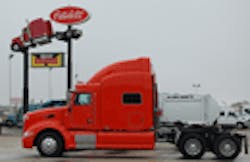Mega truck dealer sees “real” recovery arriving in 4Q 2010
SAN ANTONIO, TX. The top executives of national truck dealership chain Rush Enterprises fully expect tough times to continue for trucking until the fourth quarter of next year, when a slow but steady improvement should be evident.
“I’ve seen a lot of ups and downs in my 45 years in this business, but this [downturn] is the longest and worst I’ve ever seen,” said W. Marvin Rush, chairman and founder of Rush Enterprises, during a news conference held here at the company’s 2009 Technician Skills Rodeo.
“The reason it’s still so bad is credit – people just can’t get it, and credit is what allows businesses to survive and grow,” he explained. “So I think it will be well into next year before we start to see a recovery.”
“There’s still excess [truck] capacity out there and there’s still not a lot of freight,” added W. M. “Rusty” Rush, the company’s president & CEO. “I believe things will get better but not until the fourth quarter of next year.”
The massive decline in new home construction is also an indicator the freight market is a long way from full recovery. “When you go from annual new home construction of 2.5 million units down to 500,000 units, that severely impacts freight – because every new house represents six truckloads of freight,” he said.
Rusty Rush also noted that trucks are just not running as many miles as they used to, so they will last longer and not need replacing as soon as in even the recent past . “We have one customer that saw his average length of haul decline over the last three years from 1,050 miles to below 750 miles,” he said. “Because of declines like that, many long-haul fleets are becoming regional; in fact, fleets overall are changing their operations to fit new distribution patterns.”
As a result, fleets are also changing the types of trucks they buy, said Rusty Rush. “We’re seeing a lot more daycabs and a lot of movement to smaller sleepers,” he said. “We’re also seeing more slip-seating of drivers as fleets become more regionalized and aim to get their drivers home every night.”
The model mix of trucks is also shifting heavily towards aerodynamic cabs and smaller displacement engines, Rush noted, the better to maximize fuel savings. He added that Rush Enterprises itself is riding out the economic storm by focusing on its core business of providing parts and service to an ever broader spectrum of firms that rely on vocational trucks to deliver services.
“We went from an industry high of selling 290,000 Class 8 trucks in 2006 to down near 105,000 this year,” said Rusty Rush. “Yet we’ve maintained our absorption rate over that time, at 105% in 2006 and 2007, rising to 106% in 2008, and only slipping to 96% this year. That’s because more fleets realize they can’t afford to maintain their trucks; they need to outsource maintenance and are coming to us for help. It is up to us to be cost-efficient for the customer yet still be profitable, but this is how we’re riding out this storm.”
Though fleets remain in “survival mode” and are not spending money on trucks, Rusty Rush said some segments of the business are improving, albeit slowly.
“The refuse business is good and we’re seeing many municipalities looking to start leasing equipment since they don’t have the capital budgets to buy it,” he noted. “The truckload industry is starting to get closer to equilibrium in terms of capacity vs. freight demand, but LTL remains in recession.”
Overall, though, Rusty Rush expects 2010 to be an improvement over 2009, but what he would term a “real” economic recovery remains a ways off. “I believe things will be better next year, but not significantly until the fourth quarter,” he added.
About the Author
Sean Kilcarr
Editor in Chief
Sean Kilcarr is a former longtime FleetOwner senior editor who wrote for the publication from 2000 to 2018. He served as editor-in-chief from 2017 to 2018.
